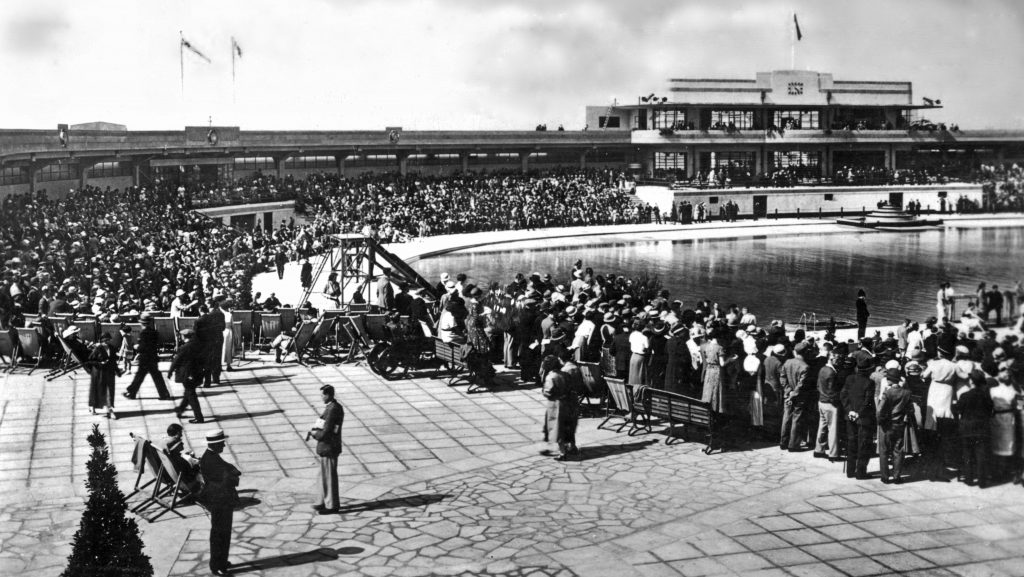Before the COVID-19 pandemic struck Great Britain this March, the Sainsbury Centre had seen one of its most successful months ever, thanks to its latest exhibition Art Deco by the Sea. Alongside fashion, furniture, paintings and textiles, it featured stunning examples of seaside villas, hotels and pleasure palaces, such as the Midland Hotel in Morecambe and the De La Warr Pavilion in Bexhill – buildings inspired by the sleek lines of ocean liners.
The Art of Escape
Art Deco by the Sea tells the story of the popular aesthetic of Britain’s coastal resorts

New Brighton lido postcard, 1930s. Lent by the Bruce Peter Collection
Exploring how inter-war art and design transformed the coasts of Britain, the exhibition proved that, while for many seaside towns the glamour might have faded, the public’s fascination with British resorts’ heyday remains strong.
Ghislaine Wood, the Sainsbury Centre’s Acting Director and curator of Art Deco by the Sea, says that due to the unprecedented circumstances facing all cultural venues this year the show’s second tour stop, The Laing Art Gallery in Newcastle upon Tyne, has provisionally agreed to take the exhibition later than originally planned. This means that visitors will hopefully be able to see it in Norwich this summer, as part of an extended run.
A Celebration of the Commercial
Art Deco was, and remains, popular for many reasons, not least because it was from the outset a commercial style. “It’s not about ideological utopianism,” Wood says, “it’s always been deeply commercial.” After World War One, many countries were competing to create popular, modern products for the home. But in 1925, the Exposition Internationale des Arts Décoratifs et Industriels Modernes in Paris was “the moment France grabbed the commercial limelight, re-establishing itself as the centre of luxury production”. Art Deco, which takes its name from the Paris exhibition, was the style which emerged onto the global stage.
Art Deco by the Sea reveals that, although unashamedly commercial, there is more than meets the eye when it comes to Deco and its impact in Britain. Deco above all marked pleasure and escape. While the style often conjures images of jazz-age Paris or New York, Wood says, “this exhibition uniquely looks at the periphery of Britain”. In Britain, as in waterfront locations from Rio to Miami, the seaside was “a creative space” where architects could experiment with modernity with a freedom unconstrained by expensive metropolitan centres.

Lives of Leisure
In 1937 seven million people summered in Blackpool. The exhibition includes a poster by Septimus Edwin Scott, advertising New Brighton for the London Midland and Scottish Railway. It features a chic female bather on a diving board. Her high-waisted shorts are displayed alongside a rare surviving 1930s exercise outfit in satin and rayon, designed for the Women’s League of Health and Beauty (which promoted mass fitness) to be practical and “expose as much skin to the open air as possible”.
Mass physical fitness groups are perhaps unfamiliar to us today; then, unrestrictive clothing and the benefits of mass exercise outdoors signalled new ways of living and new freedoms for women. It seems extraordinary now that all women over 21 only achieved the right to vote in 1928. “This is a period when women’s lives are changing,” says Wood. Despite being frequent visual motifs in Art Deco and particularly in the new “lido culture”, she says, “in the main, I don’t think it was about the objectification of women. It is about women’s bodies becoming symbolic of modernity, and about women becoming consumers: women are consuming these images, choosing to where to go on holiday and what to buy.”
A Great Deal of Decos
Another theme explored in the exhibition is the fashion for realism which underpins much imagery of the time, from Scott’s Deco posters to paintings by Dod Procter, Laura Knight and others. Many famous realist painters have “largely been written out of the art history of the period and are now little remembered”, says Wood. The show brings together an extraordinary group of paintings depicting the British coast and rural life and explores the rich connections between artists and designers. For instance Alec Walker, founder of Cryséde textiles in Newlyn, was great friends with other Newlyn School artists such as Dod and Ernst Procter. Cryséde, its name now largely forgotten, “laid the foundations for St Ives being the place it is now,” Wood says.
In her previous role as a senior curator at the V&A museum in London, Wood organised 2018’s Ocean Liners: Speed and Style and 2003’s Art Deco 1910-1939. What is it about the style that keeps her coming back? “The inter-war period is so fascinating in so many ways – it is both a time of fragility and resilience. Of course, there are many Decos,” Wood says, but one defining feature of the style is the “focus on quality, certainly at the high end.” A beautiful lacquer screen in Art Deco by the Sea by French craftsman Jean Dunand features a moonlit seascape and shows his mastery of the complex Japanese technique. “It’s just one of the most extraordinary objects. Very, very high style and extremely expensive, made for the most glorious Parisian apartment.”
Though there may be many different examples of Art Deco found in different places, Wood says the style, as a whole, embraces “the ideas of pleasure and escape, different from most other design movements. And that is life-enhancing, particularly now.”